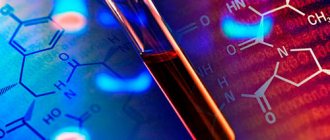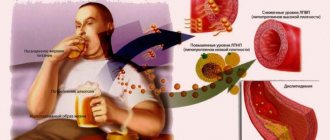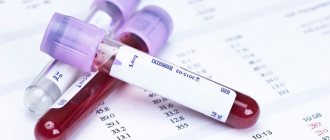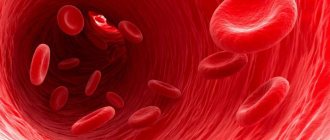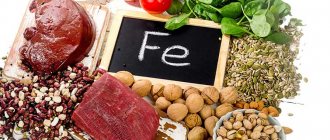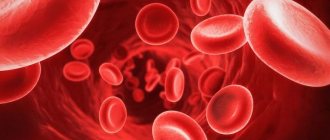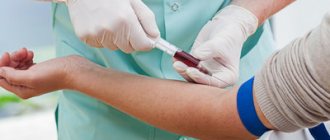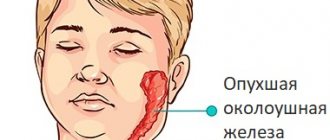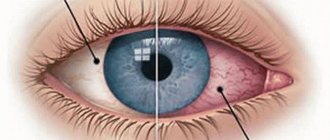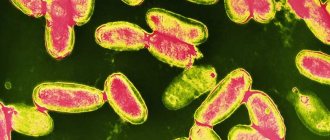- Why does hemoglobin increase in an adult?
- What does a person feel when hemoglobin is high?
- Increased hemoglobin: treatment
Hemoglobin is an element that is found inside the red blood cell. In its structure, it consists of an iron ion and a protein part. Due to various circumstances, the hemoglobin concentration in an adult may change: decrease or increase. Determining the level of this blood indicator is possible only in a laboratory way. Therefore, it is advisable to talk about increased hemoglobin only after receiving the results of a clinical analysis and diagnosing the number of red blood cells.
What is hemoglobin
Hemoglobin is a complex heme consisting of protein and iron-containing parts. The functions of hemoglobin are to transport oxygen to organs and tissues and remove carbon dioxide compounds from them.
When there is insufficient hemoglobin in the blood, anemia develops. This helps to reduce the body’s activity and deteriorate the functioning of all vital systems. At the same time, exceeding the hemoglobin norm is fraught with blood thickening.
As a result, blood vessels become blocked, blood clots form and difficulties arise in transporting oxygen. To determine the severity of the pathological process and the characteristics of its treatment, it is necessary to know the norms of hemoglobin indicators.
Treatment
When hemoglobin is elevated, the pathological root cause should first be eliminated, which can be done either conservatively or surgically, for example, when malignant neoplasms are detected.
In order for the concentration of the most important blood element to begin to decrease, patients need to follow a certain diet. First of all, you should completely avoid foods containing iron.
Thus, prohibited ingredients are:
- sour fruits and berries;
- offal and seafood;
- red meat;
- cereals and sweets;
- butter and smoked meats;
- sweet carbonated and alcoholic drinks;
- greens and legumes;
- chicken eggs and nuts;
- citrus fruits and dried fruits.
At the same time, to reduce hemoglobin in the blood, you are allowed to eat:
- dietary varieties of meat and fish;
- fresh vegetable salads;
- pasta;
- almost all types of cheeses;
- wheat bread;
- fermented milk products;
- milk chocolate.
In addition, the following medications can help reduce this substance:
Only the attending physician can decide which medication to take and for how long. This is due to the fact that a person may not know how the medicine will affect the content of the main component of red blood cells. For example, not everyone knows that hematogen increases hemoglobin.
It should be borne in mind that after the approval of the clinician, the use of folk remedies is not prohibited.
Age norms of hemoglobin
Normal hemoglobin levels vary depending on the age and gender of the patient. For men, this figure is slightly lower than for women. They are characterized by the following norms.
| Age | Norm, g/l |
| 3 months | 114 |
| 6 months | 117 |
| 1 year | 116 |
| 3 years | 118 |
| Teens and mature men | 135-160 |
Since the functions of hemoglobin are to transport oxygen, its level is very important for the proper functioning of the body. For female patients, the table looks like this.
| Age | Norm, g/l |
| 3 months | 115 |
| 6 months | 119 |
| 1 year | 118 |
| 3 years | 120 |
| Teens and mature women | 120-140 |
If normal values increase by 10 or more units, it is necessary to prescribe therapeutic therapy and a diet that allows you to restore balance in the blood composition. Neglecting your own health can cause the development of many complications and pathologies that could have been avoided with timely diagnosis and treatment.
Drug treatment
There are no drugs that reduce hemoglobin as such. To correct the condition, the underlying disease is treated. For example, for malignant tumors, chemotherapy and surgical treatment are prescribed; for coronary artery disease and hypertension, complex therapy with cardioprotectors and blood pressure regulators is prescribed. To prevent blood clots, antiplatelet drugs are prescribed:
- Chimes. Can be used during pregnancy, has coronary dilating properties. Do not use if you have high stomach acidity or hypertension.
- Trental. Improves cerebral circulation and vascular permeability, reduces blood viscosity, improves metabolic processes. With prolonged treatment, side effects may occur.
- Ticlopidine. Prescribed during the rehabilitation period after a heart attack, as well as at a high risk of blood clots in diabetes mellitus. The doctor should select the dose.
- Aspirin-Cardio. A popular drug for the prevention of blood clots, affordable and effective. It should not be used by people with gastrointestinal problems.
- Clopidogrel. The drug reduces blood viscosity, prevents the formation of blood clots, and is used in the complex treatment of atherosclerosis.
In severe cases (when the hemoglobin level increases above 200 g/l), phlebotomy (bloodletting) is performed. Heparin is first administered, then 300-400 ml of blood is taken from the patient. The procedure is carried out several times at intervals of several days until the levels drop to 150 g/l. Also, in case of significant disorders, erythrocytophoresis may be required - the collection of red blood cells using special equipment, while maintaining plasma volume.
Causes of increased hemoglobin levels
Why does a person have increased hemoglobin in the blood? What does it mean? High hemoglobin in itself is not a disease - it is only a symptom that accompanies many pathological processes occurring in the body. An increase in the indicator is typical for:
- oncological diseases;
- intestinal obstruction;
- respiratory failure;
- cardiovascular failure;
- congenital defects in the development of the heart;
- fibrosis (accumulation of dense tissue in the lungs);
- a sharp increase in the number of red blood cells (for example, during a blood transfusion);
- hormonal disorders that prevent the formation of red blood cells.
In addition to diseases, high hemoglobin levels in the blood can be a consequence of lifestyle. For people living in the mountains, high hemoglobin is the norm. This phenomenon is associated with a lack of oxygen in the air, so the body requires a larger amount of iron-containing protein for sufficient oxygen supply to tissues and organs.
Smokers also have an increased rate. Long-term smoking causes a lack of oxygen in the tissues, which is compensated by a high level of hemoglobin in the blood.
Nutrition also plays a very important role. A lack of folic acid and vitamin B12 provokes an increase in the amount of hemoglobin. To maintain balance in the body, you need to lead a healthy lifestyle, eat well, exercise and regularly walk in the fresh air.
What does an elevated Hb level in the blood indicate?
Hemoglobin contains molecules, each of which is a complex protein consisting of four hemes and globin proteins. Hemoglobin is found inside red blood cells. This protein promotes the flow of oxygen from the lungs to the tissues of other organs.
Hemoglobin level is a variable value: it is influenced by various factors:
- nature of the diet;
- climate;
- Lifestyle;
- time of year and day;
- presence of bad habits.
Most often, a lack of hemoglobin is detected, but sometimes its level exceeds the norm.
Increased hemoglobin levels may be associated with the following diseases:
- Polycythemia (erythrocytosis, erythremia) is a type of chronic leukemia, expressed in increased production of red blood cells, leukocytes and platelets, as evidenced by changes in blood composition. This condition creates a high risk of developing erythromyelosis, acute myeloid leukemia, and chronic myeloid leukemia.
- Intestinal obstruction. Under such conditions, dehydration occurs, against which the hb content increases.
- Oncological processes of the liver, kidneys. The growth of cancerous tumors of internal organs and systems is accompanied by the first capture of oxygen from the blood in significant quantities. Under such conditions, the body tries to compensate for the deficiency of formed components in the blood.
- Bone marrow pathologies (aplastic and iron deficiency anemia, leukemia).
- Diabetes.
- Pathologies of the cardiovascular system (for example, cor pulmonale, congenital heart muscle defect - mitral stenosis of rheumatic origin).
- Asthma. This disease of the respiratory system prevents sufficient air flow, as a result, the body tries to compensate for the oxygen deficiency by producing large amounts of iron-containing protein.
Experts distinguish two types of polycythemia, the most common cause of increased Hb: true and secondary. In the first case, a tumor substrate appears in the red bone marrow, which provokes increased production of red blood cells. Secondary polycythemia occurs against the background of oxygen starvation, causing the launch of compensatory processes in the body.
As the amount of formed elements in the blood increases, it becomes less fluid, and movement through the vessels becomes more difficult.
What does it mean?
We are talking about an increase in hemoglobin levels when its concentration exceeds the following indicators:
- for women – 140 g/l;
- for men – 160 g/l;
- in a child aged 5 years and older – 140 g/l.
An increase in Hb level is not a disease in itself, but indicates possible pathological processes developing in the body.
High hemoglobin can be associated with natural and pathological factors. The first group of reasons includes features of a person’s lifestyle and environment, the second group includes various diseases.
With increased hemoglobin, the following manifestations occur:
- constant fatigue;
- blue discoloration of the skin;
- body aches;
- skin itching.
Causes for men and women
From a physiological point of view, it can be explained why changes in blood composition are observed more often in women.
In women, an increase in Hb is observed during pregnancy, when taking vitamin complexes during pregnancy, which provoke excessive absorption of iron and an increase in hemoglobin in the blood.
Other factors that increase the level of hemoglobin in the blood explain why the composition of the blood is disturbed in men and women. These include:
- prolonged and heavy physical activity (including sports);
- dehydration of the body;
- prolonged smoking;
- mountaineering;
- taking anabolic steroids;
- increased physical activity;
- accommodation in mountainous areas;
- diseases of blood vessels and heart muscle (congenital and acquired defects);
- insufficient water consumption, which is especially important for those who live in hot climates;
- disease of the digestive system (intestinal obstruction);
- oncological diseases (kidney and liver tumors, bronchial carcinoma, cerebellar hemangioblastoma);
- diabetes;
- effects of carbon monoxide on the body.
Overwork, stress, and nicotine addiction can also affect hemoglobin levels: both upward and downward.
The causes and treatment of elevated hemoglobin in men and women is a pressing problem of modern medicine.
How oxygen is delivered to cells
Why does this happen to a child?
In a child, the causes of increased hemoglobin are:
- increased physical activity;
- blood diseases (various leukemias);
- congenital heart defects.
In children, the causes of changes in blood composition are usually congenital pathologies, the course of which must be monitored.
Symptoms of elevated hemoglobin
The first symptoms of increased hemoglobin levels that you should pay attention to are:
- drowsiness;
- increased fatigue;
- loss of appetite;
- pallor or redness of the skin;
- disorders in the gastrointestinal tract;
- disruption of the genitourinary system;
- decreased visual acuity;
- increased blood pressure (for no reason);
- aching joints.
If such symptoms are detected, it is necessary to take a blood test; hemoglobin will be among the main indicators. Based on the patient’s age and gender, the hematologist will be able to figure out how to build a treatment regimen and, if necessary, prescribe the correct medication and maintenance diet to reduce the level of the complex protein in the blood.
Is it possible to recognize an increase in hemoglobin by symptoms?
Small deviations from the norm do not manifest themselves in any way. Changes can be temporary (transient) and even short-term, which is also not always possible to detect.
A person’s well-being is affected by prolonged and significant excesses of hemoglobin levels above normal. It is possible to manifest both the underlying pathology (which provoked changes in the blood picture) and the consequences of negative phenomena. An increase in the amount of protein is most often associated with a change in the concentration of formed elements, which affects the basic properties of blood (viscosity, ability to clot). This has a bad effect on microcirculatory processes.
Useful information: Nitrites in urine - causes, treatment. What to do with nitrituria and is the condition dangerous?
Symptoms of increased hemoglobin may be:
- pain - headaches, joint pain, abdominal pain (usually aching);
- general discomfort - lethargy, apathy, fatigue;
- sleep disorders - a person experiences drowsiness during the day and insomnia at night, frequent awakenings or problems falling asleep are possible;
- skin manifestations - dryness, peeling, itching after contact with water, small red rashes, hematomas and bruises after minor external exposure, cyanosis, pallor or red tint of the skin and mucous membranes.
Signs of circulatory disorders may include tinnitus, migraine attacks, nosebleeds, and decreased visual acuity.
Why is an increase in hemoglobin dangerous?
For most people, elevated hemoglobin in the blood is not a concern. What does it mean? People do not pay attention to the state of their health, do not know the symptoms and reasons for the increase in this indicator, and expose themselves to danger, which manifests itself in the development of complications of existing diseases and the development of new pathologies.
- Blood thickening causes the formation of blood clots, blockage of blood vessels, and disrupts normal oxygen transport. In the absence of treatment, thrombophlebitis develops (growths of blood clots on the vessels), and then thromboembolism, which causes disruption of the functioning of vital organs due to the attachment of blood clots to them.
- High hemoglobin in pregnant women can cause fetal growth retardation, confusion and lack of cognitive abilities.
- High blood viscosity, caused by excessive hemoglobin in the blood, contributes to heart attacks and strokes.
- An imbalance in the composition of the blood causes a change in the shape of red blood cells. This pathology is called sickle anemia, since the red blood cells take the shape of a crescent and cannot do their job (attaching hemoglobin and transporting it throughout the body).
- High hemoglobin also affects the general condition of the body, causing drowsiness, weakness, lack of appetite, fatigue, dizziness and decreased performance.
If such a condition has not been diagnosed and treated for a long time, the consequences can be very serious for the functioning of the entire body.
What is increased hemoglobin and why is it dangerous?
Let's take a closer look at the causes of high hemoglobin and the treatment of this abnormality before it leads to serious health problems. Hemoglobin is a protein that transports oxygen and carbon dioxide along the lung-cell route.
The normal concentration for men is 140 g/l, and for women - 130 g/l. Doctors also note that each age category has individual indicators.
A change in the concentration of this protein by 20 units is considered a deviation from the norm. When hemoglobin decreases, doctors talk about the development of oxygen starvation (hypoxia), which can provoke premature tissue death. If the amount of protein increases excessively, then the number of red blood cells also increases.
And this, in turn, leads to blood thickening, which can cause serious disorders:
- thrombosis;
- stroke;
- heart attack;
- pulmonary thromboembolism.
Such consequences arise only due to the high concentration of hemoglobin and red blood cells. But the violation can be secondary, i.e. the result of any illness. And therein lies an even greater danger!
How to lower hemoglobin
High hemoglobin levels that are not associated with pathological processes in the body can be influenced by blood thinning medications (Aspirin, Cardiomagnyl, Curantil, Trental) and a certain balanced diet.
If you have high hemoglobin, you must adhere to the following dietary rules:
- exclude red fruits and vegetables (especially beets) from the diet;
- exclude the use of dried mushrooms and offal (liver, kidneys, heart);
- drink a large amount of water - it is important to take into account the norm (40 ml/1 kg of a person’s weight), this is necessary to prevent excess stress on the heart;
- Dairy products can reduce hemoglobin levels, as they interfere with the absorption of iron.
In rare cases, you can resort to the option of donation or erythrophoresis (reducing the number of red blood cells in the blood stream by removing them).
conclusions
Key points to remember:
- Hemoglobin is an iron-containing protein found in red blood cells that transports oxygen throughout the body.
- The average hemoglobin rate for adults is 120‒150 g/l.
- An increase of 20 units or more is considered significant.
- To check the accuracy of the blood test, you need to take it again.
- High hemoglobin increases the risk of thrombosis, heart attack, and stroke.
- Protein levels are normalized through lifestyle, diet and antiplatelet medications.
- The main method of treatment is to eliminate the provoking factor.
- Most often, a decrease in hemoglobin levels is observed with anemia (less than 110 g/l). However, a decrease in the indicator may be associated with diseases of the gastrointestinal tract, disruption of the thyroid gland, or be a consequence of an unbalanced diet. Read more about the causes, manifestations and methods of increasing low hemoglobin here.
High hemoglobin in women
High hemoglobin in pregnant women is a very dangerous phenomenon. Violation of the norm indicates that the mother has pathologies in the functioning of the kidneys and liver, as well as the presence of disturbances in the development of the child.
A woman should always adhere to proper nutrition, take vitamin complexes, spend enough time in the fresh air and lead an active lifestyle. In this case, high hemoglobin will quickly return to normal and will not cause dangerous disturbances in the functioning of the body.
Symptoms
Elevated hemoglobin has a number of characteristic clinical manifestations, however, in the vast majority of situations they go unnoticed during the course of the underlying disease.
If the average concentration of hemoglobin in a red blood cell is increased, then patients often experience the following conditions:
- lethargy and increased fatigue;
- decreased appetite;
- increased blood tone;
- severe skin itching, especially after a bath or shower;
- headaches of varying severity;
- dizziness;
- aches or pain in muscles and joints;
- bruises and bleeding even with the slightest trauma;
- drowsiness or, conversely, problems falling asleep;
- excessive pallor of the skin;
- disturbance of mental activity;
- drop in visual acuity;
- stomach ache;
- disruption of the process of urine emission - it is either accelerated or difficult.
Such symptoms occur regardless of the cause of high hemoglobin in an adult or child.
High hemoglobin in men
In men, the cause of this pathology is often bad habits, especially smoking. To prevent the development of complications, it is necessary to take a blood test at the first suspicion of increased hemoglobin in the blood. What does it mean? If you experience drowsiness, fatigue, frequent or difficult urination, or redness of the skin, it is important to consult a doctor.
A hematologist will help you establish a daily routine, talk about the need to maintain a balanced diet, physical activity, and give up bad habits that negatively affect the functioning of all vital systems.
How to reduce elevated hemoglobin in the blood
You can reduce hemoglobin with enough fluid. That is, the patient just needs to be given plenty to drink. Sufficient fluid intake (for adults - about 2 liters per day, and a liter is enough for children) is a good means of preventing not only excess hemoglobin, but also kidney pathologies. The main disadvantage of the method is the preservation of hypertension. But if the cause of blood thickening was dehydration, then there is no such problem.
Restoring fluid balance is the only way to quickly reduce hemoglobin levels, but drinking water without salt is prohibited if dehydration occurs due to severe or prolonged vomiting, diarrhea, due to massive frostbite/burns, or fighting edema (by taking diuretics). In all of these cases, “thinning” of the blood is carried out by administering saline solution intravenously.
As for attempts to reduce high hemoglobin with medication or folk remedies, we can say that this cannot be done at home, no matter how many laudatory reviews about such “treatment” methods there are on the Internet. From a medical point of view, there is no need to manufacture and take such drugs, since increased hemoglobin itself is not a pathology - only a symptom.
Chemotherapy is used to treat Vaquez's disease (blood tumor). Another scientifically approved measure in this case is erythrocytapheresis (hardware removal of a specified percentage of red blood cells from the bloodstream). Sometimes patients are prescribed bloodletting. If there is a threat of heart attack/stroke, the patient may be prescribed anticoagulants or antiplatelet agents - drugs that reduce the risk of thrombosis. The simplest and most famous among them are: “Aspirin”, “Trombo ACC”, “Curantil”.
What to refuse
Taking adaptogens with a complex composition, for example, mummy, Rhodiola rosea extract, ginseng, propolis, at best, will not give anything, and at worst, it can also cause harm, adding allergies to existing problems. But excluding some activities, medications and products from the therapeutic plan is useful.
- B vitamins. Especially if the patient eats a lot of plant foods or is treated with herbs in combination with taking them as a supplement. An incomplete series of representatives of this group is found in almost any vegetables, fruits and herbs, which is what gives them their excessive “layering”.
- Diuretics. Because they remove fluid from the body. You should stop taking any medications with this effect: both medical (Lasix) and herbal (knotweed).
- Iron. In the form of a separate product (syrup, tablets, hematogen) or as part of food products (red meat, liver, fish roe, buckwheat, all red vegetables, berries and fruits).
- Salt-free diet. As one of the options for accelerated removal of fluid from the body. Sodium chloride retains fluid in the tissues and distributes it evenly between them and the vascular bed. Refusal of it first removes fluid, and then itself begins to cause uncontrollable swelling throughout the body. With thick blood, both effects are inappropriate and dangerous, so salt must be returned to the diet.
- Squirrels. Especially of animal origin. During treatment, it is better to switch to a vegetarian diet - soy, other legumes and vegetables, but not raw, but stewed, boiled, baked, so that the temperature destroys B vitamins.
- Cholesterol. The main component of all animal fats and white matter of the brain and spinal cord. It is not involved in the synthesis of red blood cells or hemoglobin, but disturbances in its metabolism form the basis of atherosclerosis. The combination of atherosclerosis with blood thickening is dangerous due to the increased risk of thrombosis, spontaneous thrombosis caused by the rupture of one of the blood cells upon contact with the rough surface of atheromatous “growths” on the walls of blood vessels. The possibility of rupture of the vascular wall under increased blood pressure should not be discounted. Until the blood texture returns to normal, it is wiser to slow down the progress of atherosclerosis by avoiding cholesterol-rich foods.
- Smoking. Cigarette smoke contains carbon monoxide (carbon monoxide). Red blood cells bind to it instead of regular carbon dioxide, and it is much more difficult for them to get rid of it. Its regular inhalation forces the bone marrow to produce additional portions of red blood cells (to compensate for oxygen deprivation).
If it is impossible to refuse iron-rich foods, it is better to wash them down with tea - it binds and removes iron from the body. Coffee has the same effect, but it accelerates blood flow and tones the central nervous system, increasing hypertension and removing additional portions of fluid from the body, which is inappropriate with increased viscosity. Therefore, you should avoid coffee, along with other diuretics. But in such a situation you should drink black tea more often.
Strengthen your drinking regime, give up certain foods, habits or medications - these ways to lower hemoglobin in the blood can be easily implemented at home. However, any decisions regarding the withdrawal of medications (diuretics, multivitamin complexes, drugs to increase blood pressure) should be made only after consultation with a cardiologist. They are often prescribed for cardiovascular pathologies, the development of which may not depend on the increase in hemoglobin. Unauthorized refusal of them in this case threatens health.
Video on the topic Excess iron in the body
High hemoglobin in children
In newborns, the level of hemoglobin in the blood is always elevated. This is not a pathology, as it is associated with physiological processes. As you grow older, the indicator should decrease and return to normal. If this does not happen, it is necessary to exclude the presence of congenital heart defects, blood diseases and oncology.
Knowing what hemoglobin means for the human body, you can pay attention to the appearance of symptoms in time and seek medical help. With timely diagnosis and treatment, many complications and diseases can be avoided.
What is hyperhemoglobinemia
Hyperhemoglobinemia - this term means an increase in hemoglobin above the generally accepted norm in medicine. If you look at the norms of hemoglobin in the blood for children, women and men, the criteria are the following values:
- For women - above 160 g/l
- For men - above 170 g/l
- During pregnancy - above 150 g/l
- For children on their 1st birthday - more than 225 g/l
- For a one-week-old child - more than 215 g/l
- For a one-month-old baby - increase from 180 g/l
- For a one-year-old child - an increase from 145 g/l
Reasons for the increase
Increased hemoglobin is caused by various reasons: both physiological (natural) and pathological (diseases). For children, congenital diseases and defects will be more relevant, for men and women - acquired ones.
Let's first look at the physiological causes of high hemoglobin levels:
- In case of secondary erythrocytosis associated with generalized long-term (chronic) hypoxia: with altitude sickness, chronic obstructive pulmonary diseases, congenital “blue” heart defects, carboxyhemoglobinemia (in heavy smokers), hemoglobinopathies with increased affinity of Hb for oxygen, deficiency of 2,3-diphosphoglycerate in red blood cells, prolonged stay in places with low oxygen content. Such erythrocytosis is associated with an increase in the number of red blood cells (hemoglobin) against the background of an increase in the production of erythropoietin due to tissue hypoxia.
- Also, an increase in hemoglobin against the background of blood thickening (hemoconcentration): with stress, dehydration, Gaisbeck syndrome, pseudopolycythemia. These are so-called secondary relative erythrocytosis, in which there is a relative increase in red blood cells per unit volume of blood, but the total number of red blood cells and hemoglobin remains at the same level. Even donating blood on a hot day after a short run can lead to an increase in the amount of Hb in the analysis.
Hemoglobin in the blood can be increased in the following pathological conditions and diseases:
- With increased division of erythropoiesis precursor cells due to tumor transformation of a polypeptide stem cell, which is observed with erythremia.
- With secondary erythrocytosis not associated with tissue hypoxia. Such red blood cells are associated with an increase in the amount of red blood cells (hemoglobin) against the background of an increase in erythropoetin production with tumors: hypernephroide kidney cancer, cerebellar hemangoblastom, lindau gippel syndrome, hepatoma, cortical tumors, adrenal glands of adrenal glands, adenoma and hypophase. Kulinizing ovarian tumors .
- Due to increased erythropoiesis under the influence of glucocorticosteroids. In this case, the absolute number of red blood cells also increases, which leads to increased hemoglobin.
Sometimes finding the reason why hemoglobin is elevated is not easy, because... may require more extensive testing than just blood tests and medical history.
Symptoms
Possible symptoms of increased hemoglobin may include:
- Weakness
- Dyspnea
- Drowsiness
- Headache
- Increased blood pressure
- Increased fatigue
- Decreased immunity
But the main sign is the detection of an Hb level higher than normal in a general blood test, because All of the above symptoms may not be obvious.
Treatment and prevention of this problem
Drug correction of hemoglobin levels in the blood should be carried out by appropriate therapists, gynecologists, and, if necessary, hematologists. We can say that the main drugs designed to reduce blood viscosity and suppress increased thrombus formation in the body remain chimes, trental, and cardiomagnyl. You can take aspirin and its substitutes. But in this case, it is necessary to remember the high risk of developing gastric ulcers. Drug treatment of elevated hemoglobin is safe only under the supervision of a physician and with constant laboratory diagnosis of the condition of blood cells. In advanced cases, it is possible to use erythrophoesis as a method that reduces the content of red blood cells and hemoglobin in the liquid fraction of blood.
At home, you need to start with a diet. Foods high in iron are completely excluded from a woman’s diet. Nutritionists include red meat, liver, lungs and other offal here. Also sharply reduce the consumption of various cereals and red berries. The intake of red fruits should be limited.
If you have elevated hemoglobin, you should exclude red fruits from your diet.
All this should be replaced with seafood, vegetable salads made from fresh herbs, boiled chicken with bean seasoning. Animal fats, due to their high cholesterol content, which increases blood viscosity, are replaced by using vegetable oil.
For lovers of vitamin therapy, we remind you of the need to completely stop taking multivitamins containing vitamins B12, C, iron and copper. And of course a healthy lifestyle! Constant physical activity, long walks in the fresh air, swimming in open water will help cope with the problems that arise.
- Author: Anastasia
It was my last year at school, and I still couldn’t decide on my future specialization. I absolutely loved the profession of a doctor. My grandmother, also a doctor, thought that I would make a good emergency doctor. Rate this article:
- 5
- 4
- 3
- 2
- 1
(0 votes, average: 0 out of 5)
Share with your friends!
High hemoglobin. Happiness or danger to health
Those suffering from anemia will say: “Lucky guys, your hemoglobin is elevated. This means your head is not spinning, you have enough strength to turn the earth over even without a support point.” Is it so? Is it possible to be jealous? If hemoglobin in the blood is increased, what does this mean?
The level of red blood cells in the blood cannot be constant even in a healthy person. If you get injured or your monthly cycle begins, your hemoglobin drops. Everything has healed and ended - he can return to normal again. We dealt with this in the previous article. But something else is surprising: every third person has increased hemoglobin. What is the danger or is it not worth worrying about?
As a result of an increase in hemoglobin over a long period, deterioration in many parameters is observed:
- disorder in the functioning of the kidneys and genitourinary system: colic, pain, cystitis, etc.;
- visual acuity decreases;
- the skin becomes pale, in some even yellowish;
- a person gets tired quickly and wants to sleep all the time. This has already been discussed somewhere, hasn’t it;
- complete or partial lack of appetite.
Treatment of elevated hemoglobin with folk remedies
- Among the well-known folk remedies for high hemoglobin, it is worth noting treatment with leeches or hirudotherapy.
It is believed that leeches are able to regulate the composition of the blood; the leech secretion hirudin helps thin the blood and reduce blood clots, and effectively reduces the hemoglobin content.
And in fact, there is less blood - bloodsuckers suck out almost 2 times their volume of blood (if the leech itself weighs 2 grams, it can suck out 4-5 ml of blood, and usually they are given 3-4 pieces per procedure, a course of at least 10 performances every other day).
- Another method of traditional medicine is the use of mumiyo, a substance consisting of organic and inorganic compounds. It is mined in the countries of Central Asia, in Altai.
It is recommended to drink 0.1-0.2 mg of mumiyo per day for 2 weeks, after a week's break, the course is repeated.
- Herbalists recommend drinking mistletoe when there is high hemoglobin in the blood. In the evening, a teaspoon of dried herb is poured into a glass of slightly cooled hot water (50 degrees Celsius), infused, and drunk during the day in three doses. The course is three weeks, a break of 10 days, then repeat the course of treatment. Mistletoe is used for thrombophlebitis, hypertension, and helps thin thick blood.
You should also not forget about proper nutrition and lead a healthy lifestyle, which is important and what, at times, we so often forget.
Prevention and prognosis
To avoid a situation in which there is increased hemoglobin in the blood, people should follow a few simple rules.
Prevention includes the following recommendations:
- complete cessation of bad habits;
- proper and balanced nutrition;
- avoiding the influence of stress;
- taking medications strictly as prescribed by the clinician;
- use of personal protective equipment when working with chemicals and toxins;
- drinking enough liquid;
- Regularly undergoing a complete preventive examination at a medical institution.
Reducing hemoglobin
How to reduce hemoglobin in women and men? This can be done using dietetics and folk remedies, as well as medications.
Dietetics
It would be logical to assume that increased hemoglobin in women and men can be reduced by those foods that cannot be eaten if you are anemic.
It is forbidden:
- meat, offal (tongue, liver), game, smoked meats;
- beets, red vegetables and fruits, radishes;
- caviar;
- fast foods;
- full-fat milk, butter;
- cereals: buckwheat, rolled oats;
- soda;
- sweets;
- drink and drink;
- smoke.
Conclusion: you should not eat any foods that contain large amounts of iron and vitamin B12.
Can:
- seafood;
- lean fish;
- legumes;
- salads and vegetables with green fruits;
- cottage cheese;
- sour cream, kefir and other fermented milk products;
- chicken;
- drink more clean water (you remember about the water diet).
Dishes should not be fried, only boiled, raw, stewed or baked.
The table will help you navigate through foods containing iron. We choose those that contain less of this mineral.
Folk remedies
It is useful to know how to reduce hemoglobin in the blood of men or women using folk remedies, and not just food.
- A long time ago, they practiced a method such as bloodletting (by the way, it is still used quite actively now - there was an article about hijama on the website). In this case, you can contact him. You can also use leeches. They not only thin the blood, but also normalize hemoglobin levels. Just don't go to the swamps. This procedure can be done safely in clinics or medical centers.
- There are also good reviews about the effect of mumiyo, a resin that is mined in Central Asian caves. Dosage – 10 days, one tablet before bedtime.
- Become a donor. Regular donation of blood for the benefit of medicine will also benefit the sufferer.
- Salads of woodlice, squash and fireweed. We take one part of each plant, cut them and season with natural yogurt or kefir. For variety, you can also put white meat (breast) or cottage cheese there.
Official medicine
If you are wondering how to quickly lower hemoglobin in the blood, then there is only one answer - you need to consult a doctor for medical help. Drugs that thin the blood and bring its clotting back to normal will help:
Electrophoresis is very rarely prescribed. Under the influence of current, excess red blood cells are broken down and removed from the body.
It is difficult to say what is more dangerous – increased or decreased hemoglobin. But in both cases it needs to be normalized in order to live, work and enjoy life.
A woman's hemoglobin level during pregnancy
It is necessary to monitor Hb levels in preparation for conception and during pregnancy. A feature of the female body is “daily blood loss,” which shifts the hemoglobin level within 110-120 g/l.
In a pregnant woman, the blood content increases due to the development of the fetus and placenta, therefore, the standard values for hemoglobin change. With minor deviations, the normal range during pregnancy is considered to be 110-130 g/l. In rare cases, even pregnant women may experience a decrease in hemoglobin. This may cause:
- delayed fetal development;
- premature birth.
Hemoglobin readings greatly affect a woman’s reproductive functions, so it is better to undergo a full examination even before conception.
What to do if hemoglobin is elevated
It is possible to reduce the production of an element by eliminating the cause of the development of the deviation. If this symptom was caused by any pathology, then it is necessary to treat the underlying disease. To lower protein levels, doctors prescribe complex therapy, which includes:
- Diet. The patient is advised to avoid eating foods that increase iron protein levels or retain iron in the body.
- Taking medications. Prescribed exclusively by a doctor and after a blood test.
- Hirudotherapy. Treatment with leeches brings a positive effect, since the saliva of these creatures contains substances that normalize the composition of the blood. Special components reduce plasma viscosity and prevent blood from clotting too quickly.
- Blood transfusion. The procedure involves taking blood, freeing it from red blood cells and returning it to the patient. If the patient is not sick, it is better to control elevated hemoglobin by donating blood.
- Folk methods. Often alternative medicine is no less effective than medications.
Medications
Drug therapy involves taking agents that prevent platelet aggregation (clumping), which reduces the risk of blood clots, and dilate blood vessels. Medicines against high hemoglobin are allowed to be used only after consulting a doctor, since their improper use can lead to serious complications. For elevated iron protein levels, the following blood thinners are prescribed:
- Chimes. The drug inhibits the activity of platelet enzymes. Its antiagrenant effect is similar to aspirin. In addition, Curantil provides a coronary dilation effect (expands the lumens of the coronary vessels of the heart during an attack of angina). The drug is well absorbed by the digestive tract (37-66%), while its maximum concentration in the body is achieved within 1-1.5 hours. The advantages of the medicine include the possibility of taking it by people with aspirin intolerance and pregnant women. The downside is that it is prohibited to use the drug by people with high acidity and low blood pressure.
- Trental. Reduces platelet aggregation and prevents red blood cells from sticking to the walls of blood vessels, reduces blood viscosity. Pentoxifylline, which is part of the medication, thins the blood, normalizes its chemical composition and slightly dilates blood vessels. The advantage of the drug is its effectiveness and beneficial effect on the course of metabolic processes in the central nervous system and the functioning of the heart. The disadvantages include the likelihood of developing brittle nails, xerostomia, anorexia, and visual impairment due to prolonged treatment.
- Aspirin. The drug is often used to prevent blood clots. It is perfectly absorbed by the stomach and quickly gives a therapeutic effect (half an hour after administration). Aspirin can provoke the appearance of peptic ulcers, so you should take it with plenty of water/milk. The detrimental effect on the gastric mucosa is the main disadvantage of the drug. The advantages are its availability and the rapid positive effect that Aspirin has on the cardiovascular system.
- Clopidogrel. The drug inhibits platelet aggregation and reduces elevated hemoglobin levels. The doctor may prescribe clopidogrel for ischemic disorders, atherosclerosis, implantation of a coronary stent, etc. The advantage of the medication is the minimal risk of side effects. The disadvantage of Clopidogrel is the high probability of bleeding due to surgical interventions or a disrupted hemostatic system.
- Ticlid/Ticlopidine. It is prescribed for the prevention of ischemic disorders in atherosclerosis of cerebral vessels, during rehabilitation after myocardial infarction, in diabetes mellitus, etc. The advantage of the drug is its high efficiency compared to analogues, including aspirin. The disadvantage of the drug is the need to strictly adhere to the dosage, otherwise severe complications may develop in the form of hemorrhagic syndrome, etc.
Proper nutrition for high hemoglobin
Since elevated protein levels can be caused by dehydration, it is important to maintain daily fluid intake to treat the symptom. In addition, it is important to balance your diet by including healthy foods that will help stabilize your blood composition, replenish the lack of vitamins, and restore lost fluid. These types of food include fish, legumes, seafood, and greens.
In addition, if the level of iron-containing protein is high, the menu should be supplemented with chicken meat, dairy products and eggs. It is important that the food consumed is not very fatty. Since many common foods increase the hemoglobin level, they should be excluded from the diet:
- offal;
- red, fatty meat;
- any red fruits;
- smoked meats
Folk remedies
Some alternative medicine recipes can eliminate the problem of high protein content, if this pathological condition was not caused by problems with internal organs or an autoimmune disease. Particular attention should be paid to consuming sufficient fluids during treatment. At the same time, the main volume of water, compotes, herbal decoctions should be consumed during the day up to 18 hours, since after this increased fluid consumption creates a serious burden on the kidneys. Effective folk remedies to eliminate the problem:
- A decoction of birch leaves. Combine 50 g of lavender flowers, valerian root, celandine and mistletoe herbs, willow bark, rose hips. Pour 250 ml of boiling water over a spoon of the mixture, then leave for 3 hours in a thermos. The product is taken before meals for 10 days, taking 1/3 cup three times a day.
- Herbal mixture for increased amounts of protein. Shepherd's purse, horsetail, mistletoe, and dandelion root are combined in equal quantities. Boil a spoonful of the mixture for 3 minutes in a glass of water. After the infusion has cooled, it is drunk as tea, spread throughout the day.
We sound the alarm when our hemoglobin drops below normal. But believe me, hemoglobin exceeding the upper limit is no better. And now there is another task - how to reduce hemoglobin.
High hemoglobin treatment and description of the causes of the disease
The topic of today's article will be such a disease as high hemoglobin. So, let's figure out what kind of disease this is, its symptoms, causes, why it is dangerous and what consequences can occur in the absence of correct treatment or incorrect diagnosis.
In this article we will talk about:
- What is high hemoglobin?
- Let's find out the causes of the disease.
- What symptoms are prerequisites for the development of the disease?
- How does the Tibetan approach differ from modern medicine?
- How to get rid of elevated hemoglobin levels using Tibetan medicine?
- What results can you get after this treatment?
Let's go through it in order and start with defining what high hemoglobin is, what are its symptoms and causes. And most importantly, how to treat?
High hemoglobin. What it is? Concepts and definitions.
High hemoglobin is an overestimated level of hemoglobin in the blood. The hemoglobin level in the blood of a healthy woman is 120-140 g/liter of blood, and that of a healthy man is 135-160 g/l. Accordingly, a high hemoglobin level is more than 150 g/l for women and more than 170 g/l for men.
This disease can manifest itself in the form of dysfunction of the genitourinary system and pale skin color throughout the body.
The disease can appear regardless of a person's age. Including children. The cause may be, for example, an excess of glucose in the body and blood thickening.
Treatment of any disease should not be postponed. If something in your body goes wrong, there is a reason for it. We will consider further what signals the body can tell you that you are developing an increased level of hemoglobin.
Symptoms that indicate an increased level of hemoglobin in a person’s blood.
Here's what you should pay attention to. As mentioned above, if you exhibit dysfunctions of the genitourinary system and pale skin color throughout your body, it means that it is possible that you have increased hemoglobin. A more complete list of symptoms is as follows:
- Pale skin color
- Disorders of the genitourinary system
- Vision problems
- Partial or complete loss of appetite
- Increased drowsiness and fatigue of the body
- Blood thickening
Thus, if some or all of the symptoms present in the lists appear in you, then it’s time to take care of your health.
Remember, it is easier and faster to treat a disease in the early stages, when it has not yet taken root deep into your body.
Don’t let it go and don’t leave it to chance or “maybe it will go away on its own.” Undoubtedly, the body's resources are great. And Tibetan medicine is for the body to cope with the disease itself.
However, in the conditions of our modern life and without knowing the true causes of the disease, you should contact a specialist and undergo a free diagnosis in our clinic. At the very least, you will know your exact diagnosis, the cause of the disease and recommendations for a quick recovery.
Let's continue the research, and first let's find out where the roots of all diseases come from, in particular increased hemoglobin.
The root cause of increased hemoglobin. Where are the roots of all human diseases?
Our world is diverse and complex for some, but simple and great for others. The ability to behave, to subordinate thoughts to one’s will, to manage one’s condition in different situations, to launch the correct biochemical processes, allows a person to have strong energy and strong immunity, and therefore resistance to any diseases.
The integrity of the body begins to collapse with psycho-emotional factors that affect us every day. If a person knows how to cope with them, processing any emotional surges towards a positive shift forward for himself, he will be able to react easily to any uncomfortable situation, remain in good health and, moreover, develop his energy potential.
Otherwise, under the influence of a crazy pace of life, stressful situations at work, at home or on the road, a negative energy charge begins to accumulate, gradually destroying a person’s energy shell.
First, this affects a person’s psychological health; later, the destruction moves to the physical level, where internal organs begin to suffer and various sores appear.
Let's move on directly to the reasons and factors that contribute to the appearance of high hemoglobin.
“To cure someone, you must first make a correct diagnosis. And in order to be able to make a correct diagnosis, you need to have not only thorough medical knowledge, but also a genuine interest in curing the disease. It’s not enough to be a doctor, you also need to be able to help.”
Bertolt Brecht
Causes of increased hemoglobin. What can have a direct impact on the development of the disease?
We said above that the disease can be triggered by an excess of glucose in the body and thickening of the blood. There are other reasons.
The main reasons for increased hemoglobin include the following:
- Excess glucose in the body
- Increase in hemoglobin in blood plasma
- Increase in the volume of red blood cells in the blood serum
- Poor intestinal permeability
- Excess of B vitamins in the body
- Cardiovascular problems
Why can a disease be resistant to treatment, and when everything seemed to have passed, a relapse occurs? Because at the diagnostic stage the doctor did not determine the cause of the disease.
Treating symptoms means driving the disease even deeper inside, where it will affect more and more new areas, developing a whole “network” of associated diseases.
And, one “fine” day, they will make themselves felt with all their bouquet, which will also be joined by side effects from medications. Is it worth it? Of course not. There is always a choice
Next, we will consider the approach of Tibetan medicine to the issue of treating high hemoglobin.
Treatment of high hemoglobin using Tibetan medicine.
Rapid restoration of the body using Tibetan methods occurs thanks to methods of external and internal influence. Everything that can contribute to rapid recovery is taken into account. Lifestyle and nutrition also play an important role here.
During the free pulse diagnostics, you are given an accurate diagnosis, your predominant constitution is determined, which is one of the most important points for setting up the correct treatment, the causes of the disease, concomitant diseases are determined, and based on these data, treatment is prescribed.
Again, nutrition and lifestyle play an important role in the healing process. Therefore, it is important to know your natural constitution and the state of affairs in general. And based on this data, determine the necessary diet, with the presence of plenty of fluids and the exclusion or limitation of foods that are not suitable for you by nature.
The main external influences include the following procedures:
- Acupuncture
- Moxibustion therapy
- Stone therapy
- Tibetan massage
- Vacuum therapy
- Hirudotherapy
- And others.
In combination with herbal medicine, these procedures provide a tremendous healing effect and allow you to quickly relieve pain and alleviate the condition.
Properly selected herbal remedies have an immunomodulatory, antibacterial and anti-inflammatory effect, harmonizing the state of the body’s internal systems.
An integrated approach is the basis of Tibetan medicine. External influence by the above procedures leads to the following:
- Normal hemoglobin levels in the blood are restored
- Improves blood functionality
- Stagnation is eliminated
- Increases immunity
- Relieves pain and discomfort
- Concomitant diseases go away
- The general condition of the body improves
- Pale skin color goes away
- The functions of the genitourinary system are restored
- Vision improves
- The former appetite returns
- Increased drowsiness and fatigue of the body are reduced
Tibetan medicine has helped many patients regain lost health. Even in those cases when ordinary doctors refused the patient, saying that he could no longer be helped, Tibetan medicine helped.
Not because she has some kind of magic pill, but because she has enormous knowledge about human nature and its interaction with this world. This experience has been accumulated over thousands of years and is now quickly gaining popularity due to its amazing results.
Without chemicals, antibiotics, painful procedures and surgeries, we manage to get people back on their feet, significantly improving their condition.
People also come to us to prevent diseases. Relax, unload your emotional state, raise your vitality and restore your energy.
After complex procedures, a person gains harmony with himself and the outside world for a long time. He simply glows with love, energy and life.
Therefore, if you have any health problems, come, we will help you.
Health to you and your loved ones!
Diagnostics
Detection of increased hemoglobin in women is carried out only using a general clinical blood test; biological material is collected from a finger or from a vein. The procedure is generally accepted and is not prohibited during pregnancy. There is no need to prepare for the analysis in advance.
The information obtained will not be enough to find out why hemoglobin is increased in the blood of women - a comprehensive examination of the body is necessary.
General diagnostics begins with the following manipulations:
- studying the patient's medical history;
- familiarization with family history;
- collection and analysis of life history - information regarding lifestyle, food habits and medication intake is important for the doctor;
- a thorough physical examination;
- assessment of the condition of the skin and mucous membranes;
- measuring temperature, heart rate and blood tone;
- a detailed survey will indicate to the specialist the complete symptomatic picture, and can often indicate the provoking disease.
Additional laboratory and instrumental diagnostics are selected individually, in accordance with complaints and data obtained during previous diagnostic measures.
Hemoglobin norm for women
Signs
An increase in hemoglobin in the blood can be detected through testing. The following symptoms are grounds for examination:
- drowsiness;
- dysfunction of the genitourinary system;
- paleness/redness of the skin;
- decreased visual acuity;
- loss of appetite;
- high fatigue;
- increased blood pressure;
- aching joints.
How to lower the level
To lower your hemoglobin level, you must first determine the cause. To thin the blood, doctors prescribe the following drugs:
- Chime;
- Aspirin, or salicylic acid;
- Trental;
- Cardiomagnyl.
You should not self-medicate. These drugs can only be taken as prescribed by a doctor.
Sometimes the doctor recommends electrophoresis. This is a very effective procedure that has stood the test of time.
Traditional medicine for blood thinning offers a large number of effective methods.
For example:
- Hirudotherapy, or treatment with leeches. This method of treatment not only helps to normalize the blood condition, but also improves immunity.
- Donation. In the old days, doctors practiced bloodletting. Now, in the absence of contraindications from the attending physician, you can engage in this useful activity. The first time they donate 200 ml of blood. Then the amount of blood taken is increased to 400 ml.
Women are recommended to donate blood once every two months.
- Reception of mumiyo. This drug not only improves the blood condition, but also prevents the development of osteoporosis. Therefore, mumiyo courses are recommended for all women after menopause.
When treating mumiyo, you should never drink alcohol or meat. You can eat fish and seafood twice a week. You need to take the drug according to the instructions, that is, one tablet twice a day before meals for one month.
It is better to dissolve the tablet in a small amount of warm water first.
- Tea with fireweed. Regularly drinking tea with this herb normalizes hemoglobin concentration, improves immunity and helps reduce blood sugar.
What should be the diet for high cholesterol in women? We will tell you about the rules of nutrition at high levels in our project.
In our next article, read about the symptoms of weakened immunity in adults, as well as ways to maintain it.
Read about the normal level of cholesterol in the blood of pregnant women in our special review: .
